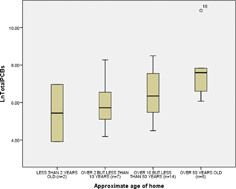Polychlorinated biphenyl (PCB) and dioxin concentrations in residential dust of pregnant women†
Abstract
Polychlorinated biphenyls (PCBs) and dioxins are well known for their persistence in the environment. PCBs can be found in the residential environment long after the use of these chemicals in domestic products and industrial processes has ceased. Dioxins have been assessed in Australia as being of very low concentrations. Despite concerns about residential dust as a source of human exposure to persistent chemicals, there has been limited testing of PCBs and dioxins in dust in Australia. As part of an assessment of maternal exposure to a variety of persistent toxic substances, we analysed 30 residential dust samples from a variety of geographical settings for their dioxin and PCB concentrations. PCBs were found in most samples, the median and range concentrations (pg g−1) of dominant congeners of PCB were as follows: PCB118 (315; <35.0–29 000), PCB105 (130; 14.0–16 000) and PCB156 (440; <5.00–2800). Dioxin concentrations were generally low with median concentrations for the total sum of dioxin-like polychlorinated dibenzodioxins (PCDDs) and polychlorinated dibenzofurans (PCDFs) of 3.75 pg g−1 each. There was a very high percentage of non-detects. Concentrations of both PCBs and dioxins were low compared with most studies reporting residential dust concentrations internationally. Age of dwelling was the only factor observed to influence both PCB congener concentrations and dioxin isomers in multivariate regression analyses. No other housing or sociodemographic variables, including proximity to industry, were important predictors in multivariate linear regression models.


 Please wait while we load your content...
Please wait while we load your content...